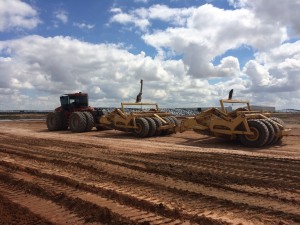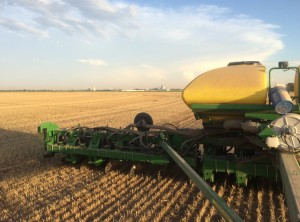
Most of the Quarter Sections are irritated with a a sprinkler system that rotates on one center pivot. As a result the crops must be planted in a circular pattern.
Week 1
Over ten years ago the Dairy I am interning with made the difficult decision to relocate from their dairy in northern California to the Panhandle of Texas. Over the past decade the Family has accumulated 4 individual dairy farms and a calf ranch and milk a total of 14,000 Holsteins. In addition to managing their cows company works approximately 16,000 aces, three quarters of which are under center pivot irrigation. The Texas Panhandle has experienced an extreme drought over the past 5 years depleting the ground water supply which they depend on by 25%.
This is there first year adding an intern position to their payroll of nearly 350 people. I found the job through the Network I have been creating at Cornell. A former professor introduced me to a Cornell alum who was offering the job.
My role as intern will consist of helping to improve and maintain the organization of their cropping operations in addition to completing basic tasks around the farm. Extensive networks of irrigation are an important factor for the farm profitability as the arable land provides over 75% of the feed for the dairy portion of the farm.
After a complete tour of all 5 farms and many introductions on the first day I was prepared to begin my role on the farm. The following day I learned how to operate a laser leveler moving earth from one location to another in order to prepare a foundation for a new hay barn to be constructed upon. Wednesday I received a 30 minute crash course on how to plant sorghum with a 32 row planter and operate John Deere’s Green Star software in order to plant sorghum, a drought tolerant crop commonly used for silage in Texas. Two and a half days later I already had 470 acres under my belt as my employers moved me to my next task. The main purpose of my intern position would be to gather information on each quarter section (an field consisting of 160acres) the farm owned. Over the next 7 weeks I will be gathering GPS coordinates, soil composition information and cropping records in oder to compose documents that will further improve the growers ability to efficiently produce high quality forages for 14,000 animals.


